Exploring the Key Differences and Similarities Between Autism Spectrum Disorder and Down Syndrome
Autism Spectrum Disorder (ASD) and Down syndrome are two prominent neurodevelopmental conditions that affect individuals across various aspects of their physical, cognitive, and social development. While they have distinct origins and characteristic features, they also share overlapping traits, leading to challenges in diagnosis and support. Recognizing how these conditions differ and intersect is essential for early intervention, tailored educational strategies, and comprehensive care. This article provides an in-depth comparison of autism and Down syndrome, examining their causes, symptoms, diagnosis process, co-occurrence, and available resources for support.
Overview of Autism Spectrum Disorder and Down Syndrome
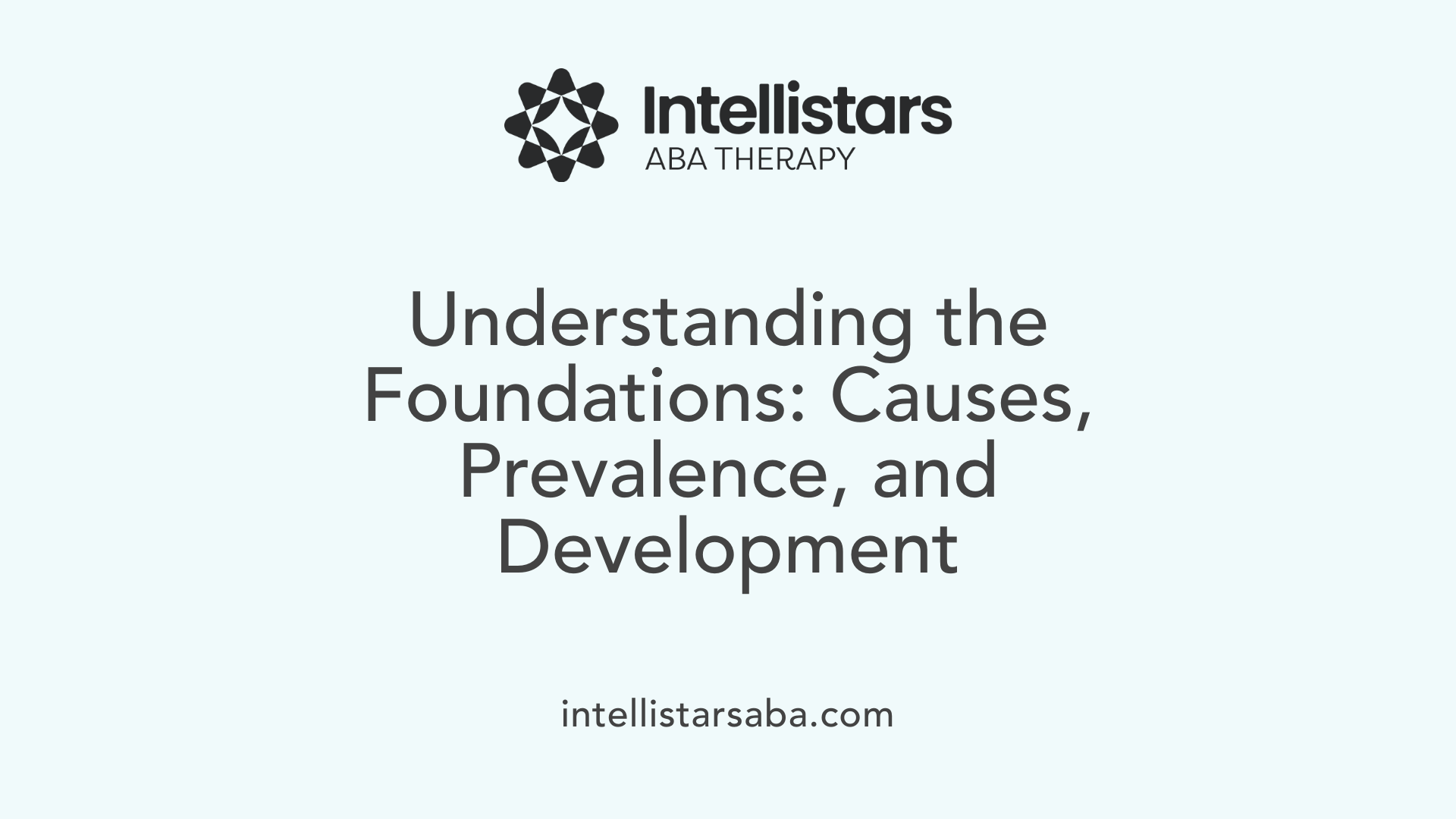
What is known about the causes, prevalence, and development patterns of autism spectrum disorder and Down syndrome?
Autism spectrum disorder (ASD) is a complex neurodevelopmental condition that affects how individuals communicate, behave, and interact socially. Symptoms commonly appear between ages 2 and 3, characterized by challenges in social interaction, restricted interests, and repetitive behaviors. The causes of autism are varied and include a combination of genetic and environmental factors. Over 800 genes have been linked to autism, and in some cases, environmental influences during pregnancy or birth—such as prenatal exposure to toxins or complications—may contribute. Heritability estimates for autism are high, ranging from 70% to 90%, suggesting a strong genetic component.
In contrast, Down syndrome is a genetic disorder caused by an extra copy of chromosome 21, known as trisomy 21. It typically occurs due to random nondisjunction during the formation of reproductive cells, making it non-hereditary in the usual sense. People with Down syndrome often exhibit distinctive physical features such as a flattened facial profile, upward-slanting eyes, and a small nose. Developmentally, they tend to experience mild to moderate intellectual disabilities and face various health issues like heart defects and gastrointestinal problems.
Prevalence rates differ for both conditions. Down syndrome affects approximately 1 in 700 live births in the United States. Autism spectrum disorder, on the other hand, affects about 1 in 59 children according to recent data, with some estimates suggesting as many as 1 in 44. Both conditions can be diagnosed prenatally through genetic testing or after birth via physical examinations and medical assessments.
The development patterns of children with these conditions vary widely. Children with Down syndrome often reach developmental milestones later than typical, but with support, they can make steady progress. Meanwhile, children with autism may show uneven cognitive development, including developmental regression and unique behavioral challenges. When autism occurs alongside Down syndrome—a co-occurrence known as dual diagnosis—it complicates the developmental trajectory, often leading to more pronounced social and behavioral difficulties.
Early identification and diagnosis are crucial for both conditions. They allow for timely intervention, which can significantly improve developmental outcomes and quality of life for affected individuals.
Overall, understanding the causes and prevalence of autism and Down syndrome helps in tailoring appropriate support and educational plans to meet the diverse needs of individuals, enabling better integration and participation in everyday life.
Shared and Distinct Characteristics
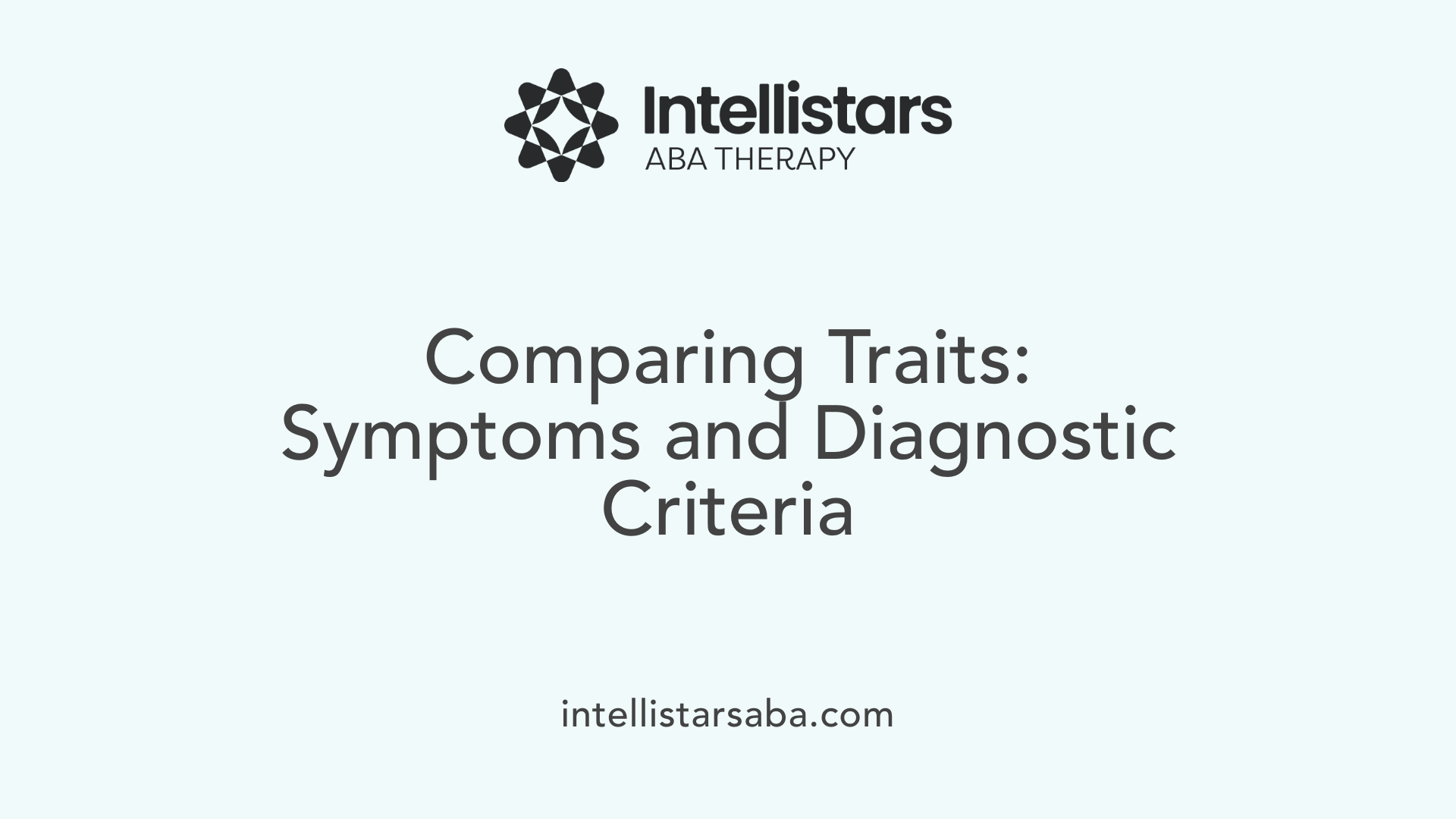
How do autism spectrum disorder and Down syndrome compare in terms of characteristic symptoms and diagnostic criteria?
Autism spectrum disorder (ASD) and Down syndrome are different conditions with unique origins and features, but they can overlap in some behavioral aspects.
Autism is primarily a neurodevelopmental disorder characterized by persistent challenges in social communication and interaction, along with restricted, repetitive behaviors and sensory sensitivities. Children with autism often exhibit reduced eye contact, limited use of gestures, difficulty responding to social cues, and may show repetitive actions such as lining up objects or repeating phrases. They might also display sensory over-responsiveness, such as reactiveness to loud noises or textures.
Down syndrome, on the other hand, is a genetic condition caused by an extra copy of chromosome 21. It results in distinct physical features like a flatter facial profile, upward-slanting almond-shaped eyes, a small nose, and a single deep crease across the palm. Cognitively, individuals typically experience mild to moderate intellectual disability, and they often reach developmental milestones later than typical peers.
While these conditions are different, they can coexist, leading to a combined profile known as DS-ASD. Individuals with this dual diagnosis tend to have more significant difficulties in social communication and behavioral regulation.
Diagnosing autism in individuals with Down syndrome requires careful assessment by specialists because some behaviors — such as delays in speech or social engagement — can be inherent to Down syndrome itself. Standardized tools like the Autism Diagnostic Observation Schedule (ADOS) or the Autism Diagnostic Interview-Revised (ADI-R) are used, but clinicians must interpret results within the context of the individual's overall development.
In summary, autism’s core symptoms involve social and communication difficulties along with repetitive behaviors and sensory sensitivities, whereas Down syndrome’s hallmark features are physical traits and developmental delays. When they co-occur, careful evaluation helps tailor interventions to meet the complex needs of the individual.
Prevalence and Co-occurrence of Autism in Down Syndrome
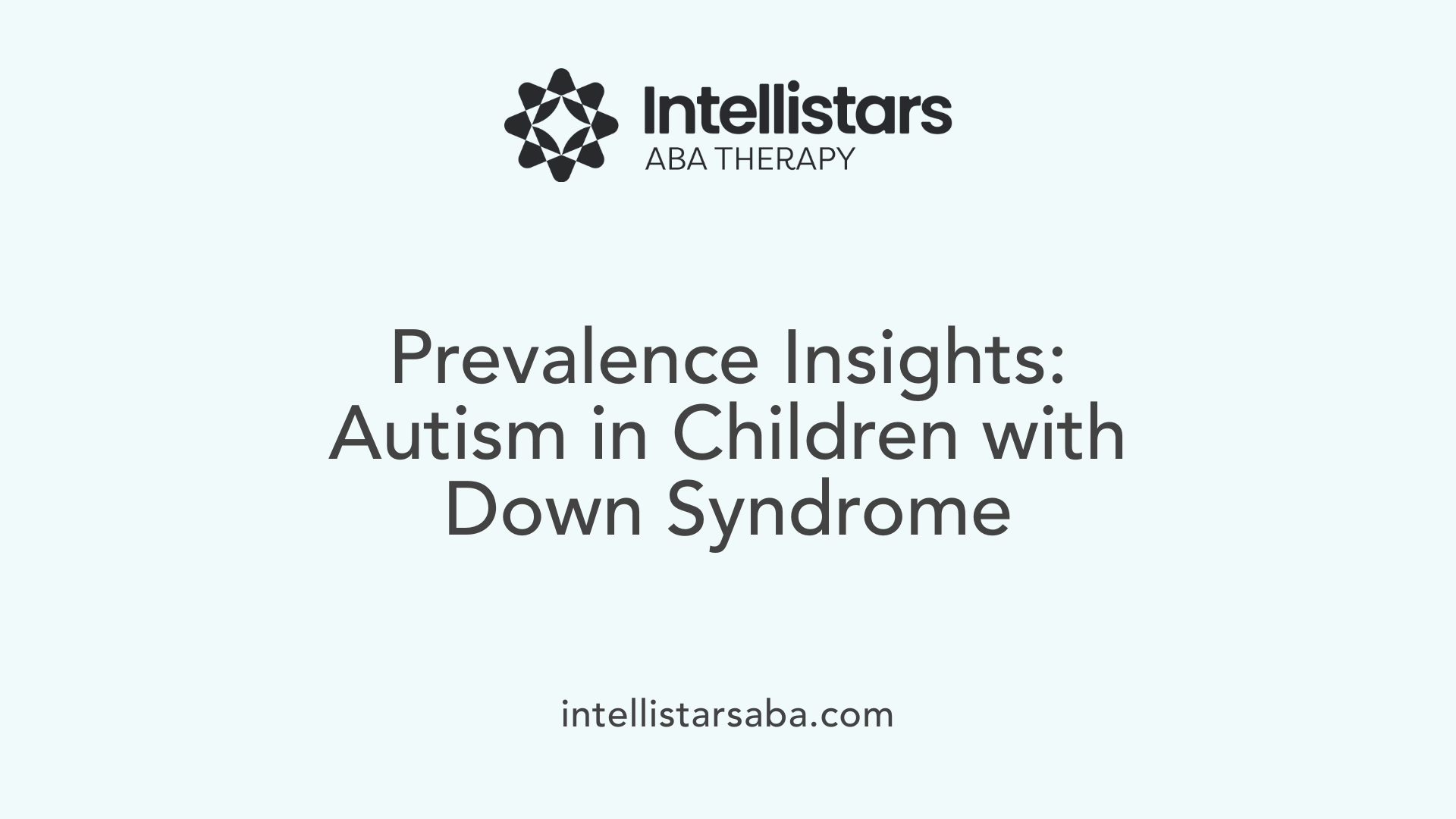
What is known about the causes, prevalence, and development patterns of autism spectrum disorder and Down syndrome?
The occurrence of autism spectrum disorder (ASD) among individuals with Down syndrome (DS) has been extensively studied, revealing that about 16-18% of people with DS also have ASD. Some studies report a prevalence as high as 39%, highlighting that comorbidity is more common than previously thought. This dual diagnosis, often called DS-ASD, signifies that a significant portion of the Down syndrome population faces additional challenges linked to autism.
The causes of ASD in children with DS are complex and not fully understood. Autism is believed to result from a mix of genetic and environmental factors that affect brain development. For individuals with Down syndrome, the extra chromosome 21 adds another layer of genetic complexity, which may influence the development of autism symptoms.
Developmentally, children with both conditions tend to demonstrate more severe difficulties than those with only Down syndrome. These include greater impairments in social skills, communication, and behavior. They often experience developmental regression, particularly in language and social skills. Sensory sensitivities—such as reactions to loud noises, particular textures, or smells—are common and may be more pronounced.
The severity and pattern of ASD symptoms can vary widely among children with DS. Some may show significant delays, hyperactivity, and behavioral challenges, whereas others may demonstrate milder symptoms with better adaptive skills.
Understanding the range of developmental trajectories in these children is vital for early diagnosis and intervention. Children with dual diagnoses require tailored support strategies, including behavioral therapies, speech and occupational therapy, and sometimes medication.
Early identification of ASD traits in children with Down syndrome plays a crucial role in improving outcomes. When detected early, targeted interventions can help manage behaviors, support communication development, and enhance social participation.
The variability in how ASD manifests in individuals with DS highlights the importance of personalized approaches. Some children may exhibit more noticeable behavioral challenges, while others might have relatively preserved cognitive or language skills but struggle with sensory issues.
Ongoing research, including studies at institutions like Kennedy Krieger Institute, continues to shed light on the neurobehavioral aspects of DS-ASD. Using advanced tools such as MRI scans, researchers have found differences in brain structures like the cerebellum and corpus callosum in children with DS-ASD compared to those with Down syndrome alone.
Overall, recognizing and understanding the prevalence and diverse development patterns of ASD in Down syndrome is essential for providing effective support. It underscores the importance of thorough screening, consistent evaluation, and early intervention to enhance developmental outcomes and improve quality of life for these children.
Signs and Diagnosis of Autism in Individuals with Down Syndrome
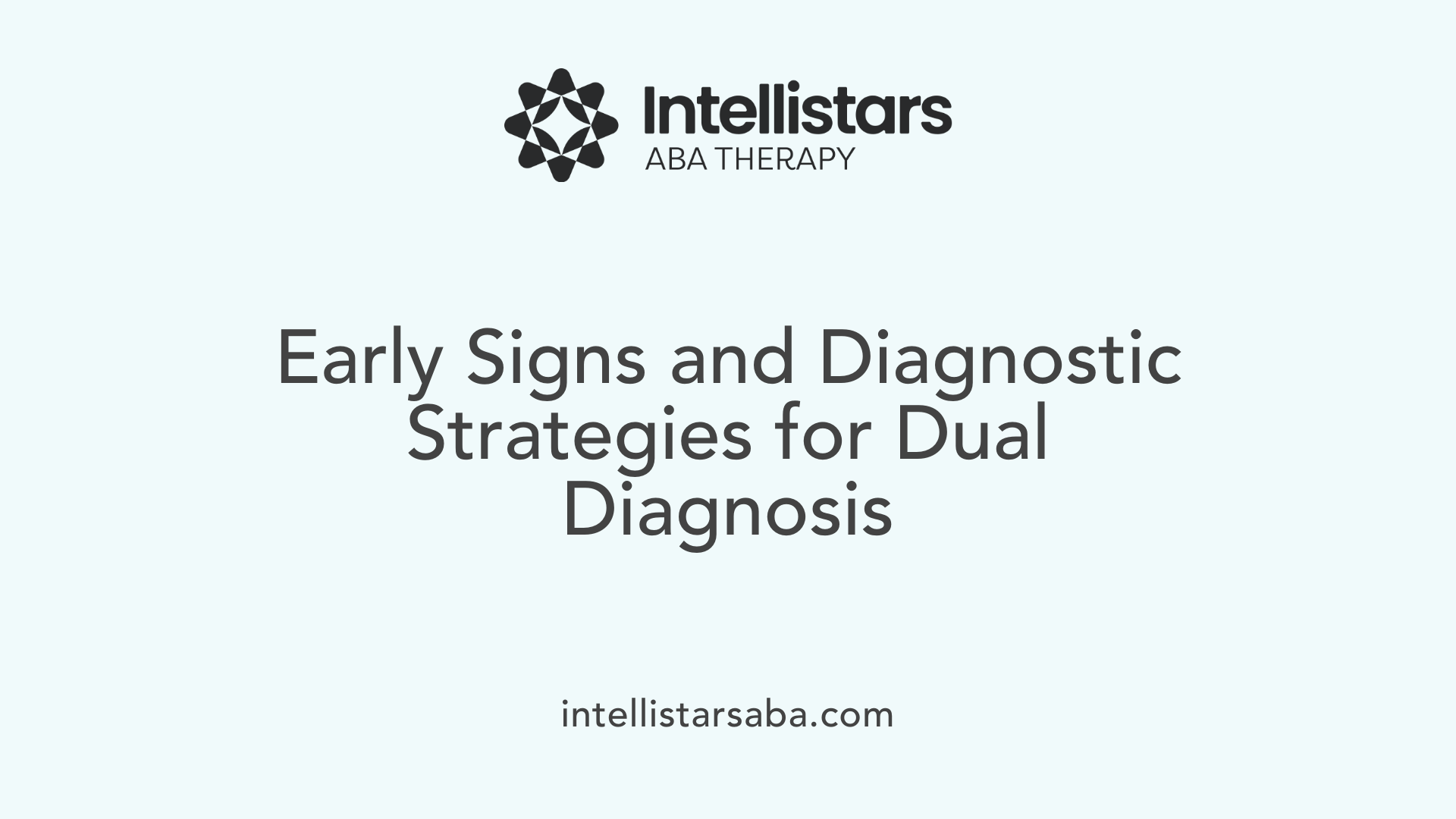
How do autism spectrum disorder and Down syndrome compare in terms of characteristic symptoms and diagnostic criteria?
Autism spectrum disorder (ASD) and Down syndrome are distinct conditions, but they can overlap in some behavioral features. Autism is a neurodevelopmental disorder characterized by challenges in social interaction, communication difficulties, repetitive behaviors, and sensory sensitivities. These symptoms can vary widely in severity and presentation.
Down syndrome, caused by an extra copy of chromosome 21, presents with physical traits such as upward-slanting eyes, flattened facial features, and a short neck. It also involves developmental delays, intellectual disabilities, and health issues like heart defects and vision problems.
Diagnosing ASD in individuals with Down syndrome (DS-ASD) is complex because many physical and developmental traits of DS can mask or mimic autism signs. For example, delayed speech and social withdrawal might be common in DS but could also indicate ASD.
In children with DS-ASD, typical signs include reduced eye contact, limited use of gestures like pointing or waving, and difficulties responding to their name or other cues. Repetitive behaviors such as hand-flapping, lining up objects, or repetitive phrases are also observed. Sensory sensitivities are common, with children reacting strongly to loud noises, textures, or bright lights.
Behavioral challenges such as irritability, tantrums, and difficulty coping with routine changes often appear. These behaviors tend to be more pronounced in children with both conditions than in those with DS alone.
To differentiate and accurately diagnose ASD in these children, clinicians utilize standardized assessment tools like the Autism Diagnostic Observation Schedule (ADOS), the Childhood Autism Rating Scale (CARS), and screening questionnaires such as the Modified Checklist for Autism in Toddlers (M-CHAT). Although these tools are valuable, no assessment is specifically designed for children with DS; thus, evaluations often require specialized interpretation.
Early identification of autism signs is essential. Developmental surveillance, which involves regular check-ups and observations from infancy, helps pick up early signs of ASD. Recognizing these signs promptly allows for earlier intervention, which can significantly impact the child's developmental trajectory.
Early initiatives include speech, occupational, and behavioral therapies tailored to the child's needs. These interventions aim to improve social skills, communication, and reduce challenging behaviors, fostering better integration into social and educational environments.
In summary, while ASD and Down syndrome have distinct features, their overlap necessitates careful and comprehensive assessment for accurate diagnosis. Early detection is critical for implementing support strategies that optimize developmental outcomes.
Medical and Behavioral Challenges in Co-occurring Conditions
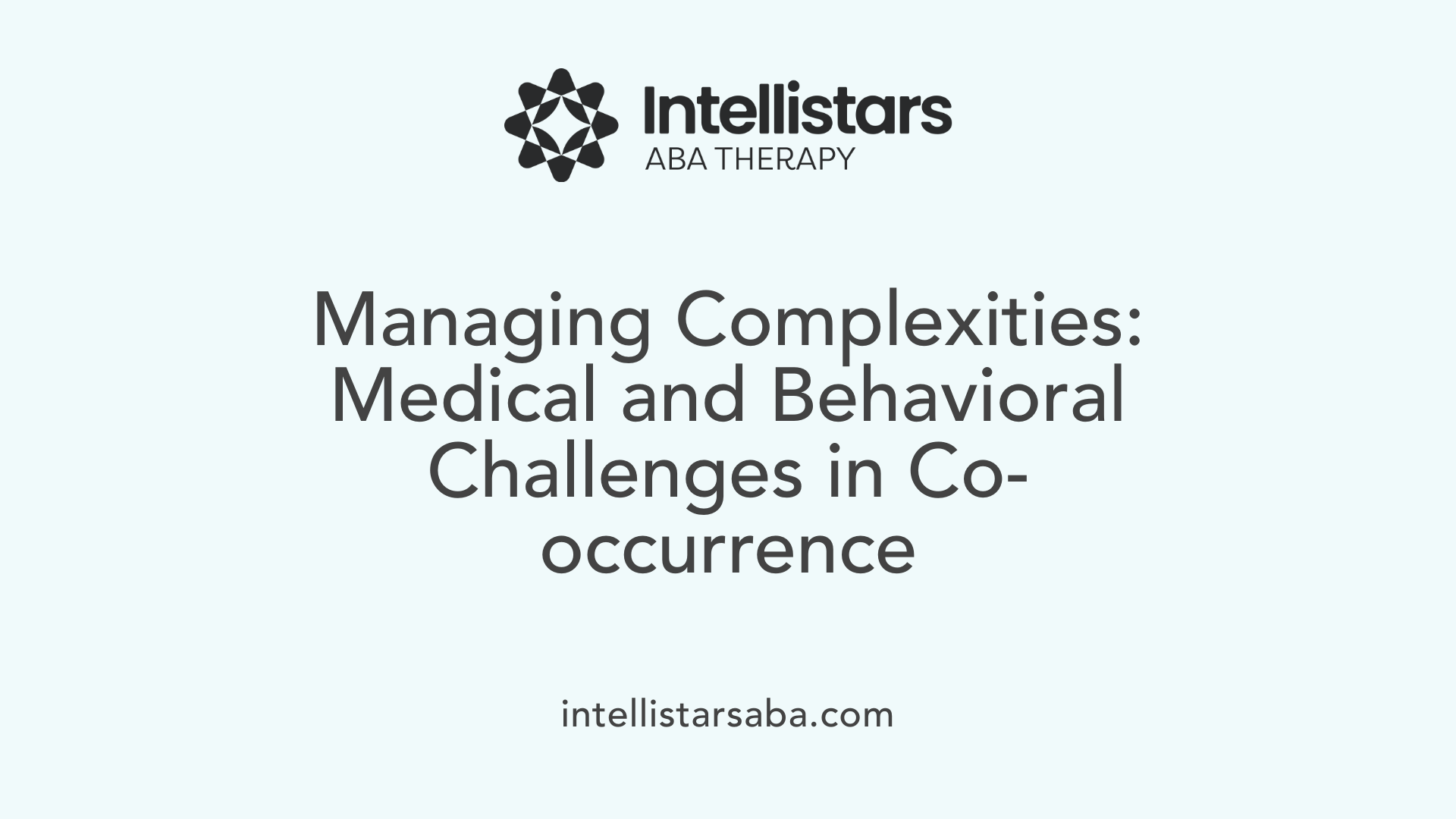
What are the similarities and differences between autism spectrum disorder and Down syndrome?
Autism spectrum disorder (ASD) and Down syndrome (DS) are both complex neurodevelopmental conditions that can significantly impact an individual's development. They often share some behavioral features such as challenges in social interactions and sensory sensitivities, which can make them appear similar on the surface. However, the underlying causes, physical traits, and typical developmental profiles differ substantially.
Individuals with Down syndrome typically exhibit distinctive physical features like a flattened facial profile, upward-slanting almond-shaped eyes, a small nose, and a single deep crease across the palm. Their cognitive impairments tend to range from mild to moderate, with a relatively stable developmental trajectory. In contrast, autism is characterized more by challenges in social communication, restrictive and repetitive behaviors, and sensory processing sensitivities, without specific physical traits. Autism's presentation can vary widely, from severe delays to exceptional talents, and its core involves difficulties with reciprocal social interaction and communication.
When both conditions co-occur, often called dual diagnosis, individuals may experience compounded challenges. They could show more pronounced behavioral issues, including intense sensory reactions, difficulties maintaining routines, and social engagement issues. These combined difficulties require careful, personalized intervention strategies.
Medical conditions more common in Down syndrome—such as congenital heart defects, vision and hearing problems, sleep apnea, hypothyroidism, and gastrointestinal issues—can add complexity to managing behavioral and developmental challenges in children with DS-ASD. These health issues may influence behaviors, such as irritability or sleep disturbances, and can impact the effectiveness of therapies.
Effective management of dual diagnosis involves an integrated healthcare approach. This includes medical treatments for health conditions, behavioral therapies such as applied behavior analysis (ABA), speech and occupational therapy, and educational support tailored to individual child profiles. Early and thorough evaluation by specialists is crucial to identify the specific needs and to implement supportive interventions promptly.
| Aspects | Autism Spectrum Disorder | Down Syndrome | Co-occurrence (DS-ASD) |
|---|---|---|---|
| Physical Traits | No distinctive physical features | Flattened face, upward-slanting eyes, small nose | Combination of features from DS; behavioral challenges from ASD |
| Cognitive Profile | Varied; often uneven, can include giftedness | Mild to moderate intellectual disability | Pronounced cognitive challenges, slower processing |
| Behavioral Traits | Repetitive movements, rituals, sensory sensitivities | Mild to moderate delays, language articulation issues | Increased severity, sensory sensitivities, behavioral disturbances |
| Common Medical Conditions | Gastrointestinal issues, sleep problems | Heart defects, vision/hearing problems, hypothyroidism | Presence of both sets, requiring comprehensive care |
Understanding these differences and overlaps helps educators, healthcare providers, and families formulate effective support strategies. Early diagnosis and intervention are vital for improving developmental outcomes and quality of life for children with DS-ASD.
For more detailed information on managing these conditions, research can be expanded using, for example, the search query "Medical and behavioral challenges in autism and Down syndrome," which provides access to research studies, reviews, and clinical guidelines in this area.
Interventions, Supports, and Resources
What support organizations and advocacy groups are available for individuals with Down syndrome and autism spectrum disorder?
Families, caregivers, and professionals have access to a wide network of organizations dedicated to supporting individuals with Down syndrome and ASD. These groups provide resources, advocacy, educational programs, and community connections.
Some notable organizations include the Down Syndrome Resource Foundation, Autism Speaks, the National Down Syndrome Society, and local affiliates. These agencies offer a variety of services such as support groups, training seminars, and access to specialized therapies.
They also facilitate advocacy efforts to improve healthcare, education, and social inclusion for those affected. Many organizations host events, provide informational materials, and connect families with ongoing support networks.
What are effective approaches like behavioral therapies and educational strategies?
Behavioral interventions, especially Applied Behavior Analysis (ABA), are widely used to improve social, communication, and adaptive skills in children with dual diagnosis. ABA involves structured techniques to reinforce desirable behaviors and reduce problematic ones.
Educational strategies tailored for children with Down syndrome and ASD often include the development of Individualized Education Programs (IEPs). These plans customize learning goals, therapies, and accommodations to meet each child's unique needs.
The use of visual supports, structured routines, and communication devices can enhance learning and social interactions.
How do resources help parents, caregivers, and professionals?
Resources aimed at families and educators provide crucial guidance in understanding complex conditions, managing behaviors, and fostering development.
Educational materials such as books, workshops, and online courses offer evidence-based practices and practical advice. For example, the book 'When Down Syndrome and Autism Intersect' offers insights into managing dual diagnoses.
Support organizations also advocate for policy changes and increased access to services. They organize community events and provide forums for experience-sharing, reducing feelings of isolation among families.
What online tools and government programs are available?
Digital platforms and research reports from agencies like the Centers for Disease Control and Prevention (CDC) and the National Institute of Child Health and Human Development (NICHD) keep families updated on latest findings, screening tools, and intervention strategies.
Tools such as online screening questionnaires (like M-CHAT) assist early detection. Telehealth services provide remote therapy sessions, which have become increasingly important.
By engaging with these diverse resources, families and caregivers can navigate the multifaceted challenges of autism and Down syndrome with greater confidence and support.
| Support Resource | Focus Area | Description |
|---|---|---|
| Down Syndrome Resource Foundation | Community Support | Offers educational programs and therapies tailored for Down syndrome |
| Autism Speaks | Advocacy & Research | Provides information, funding, and support networks for autism |
| National Down Syndrome Society | Education & Support | Focuses on awareness, advocacy, and resources specific to Down syndrome |
| Local support groups | Community & Peer Support | Facilitate peer connections and shared experiences |
| IEPs and educational plans | Education Management | Customizes learning and support strategies in school settings |
| Online screening tools | Early Detection | M-CHAT and other assessments for early signs |
| Government programs | Public Health | CDC, NICHD provide guidelines, data, and resources |
Emphasizing early identification and ongoing support through these organizations and tools significantly enhances developmental outcomes and quality of life for individuals with both conditions.
Impact and Long-term Outlook
What is the life expectancy for individuals with Down syndrome and autism?
The lifespan of individuals with Down syndrome has seen remarkable improvements over recent decades. Today, they typically live into their 50s and 60s, with many reaching around 60 years of age or beyond. A significant health concern for many with Down syndrome is the development of Alzheimer’s disease, often beginning around age 40, which can affect longevity.
In contrast, lifespan estimates for individuals with autism spectrum disorder (ASD) vary considerably. Those with milder forms of autism and fewer health complications tend to have a life expectancy close to that of the general population, which is around 80 years in many countries. However, individuals with more significant neurodevelopmental and health challenges may have a shorter lifespan, often ranging from about 35 to 60 years.
Overall, current research indicates that the average life expectancy for autistic individuals falls in the mid-40s to mid-50s, though ongoing advances in healthcare, early diagnosis, and intervention strategies are helping improve these numbers. Proper medical management and supportive care, including therapies and regular health monitoring, greatly contribute to enhancing both lifespan and quality of life.
How does early and tailored intervention influence long-term outcomes?
Early intervention plays a crucial role in shaping positive long-term outcomes for individuals with both Down syndrome and autism. When developmental delays and behavioral concerns are identified promptly, targeted therapies such as speech, occupational, behavioral, and physical therapy can significantly improve communication skills, social interaction, and daily living skills.
Customized support plans, often incorporated into individual education programs (IEPs), enable children to develop their strengths and address specific challenges. This proactive approach helps reduce behavioral difficulties and promotes independence.
Furthermore, early intervention increases the likelihood of better healthcare management, reducing the risk of secondary health issues. For example, addressing sensory sensitivities, motor skills, and behavioral difficulties early can prevent escalation and improve overall well-being.
As children grow, ongoing support tailored to their evolving needs ensures they can participate more fully in society, pursue education, and develop meaningful relationships. Early and personalized interventions are thus vital for maximizing potential, improving life quality, and fostering long-term health and happiness.
| Aspect | Impact | Additional Details |
|---|---|---|
| Lifespan Expectations | Significantly improved with medical advances | Slight variations depending on severity and health conditions |
| Quality of Life | Enhanced through therapies and support | Focus on social inclusion and personal independence |
| Early and Tailored Interventions | Critical for positive outcomes | Involves behavioral, educational, and medical strategies |
This dynamic and person-centered approach underscores the importance of early detection and individual support in managing conditions like Down syndrome and autism to promote long, healthy, and fulfilling lives.
Summary and Future Directions
How do autism spectrum disorder and Down syndrome compare in terms of characteristic symptoms and diagnostic criteria?
Autism spectrum disorder (ASD) and Down syndrome are distinct conditions with overlapping but also unique traits. ASD primarily involves challenges with social communication, sensory sensitivities, and restrictive or repetitive behaviors. These symptoms are identified through behavioral assessments such as the Autism Diagnostic Observation Schedule (ADOS) and supplemented with parental and clinical observations. Children with ASD often exhibit difficulties in understanding social cues, engaging in typical play, and managing sensory input.
In contrast, Down syndrome is a genetic condition caused by an extra copy of chromosome 21. It is characterized by physical features like almond-shaped eyes with an upward slant, a flat facial profile, short stature, and developmental delays. Diagnosis is usually confirmed through genetic testing, including karyotyping, which detects trisomy 21.
When ASD co-occurs with Down syndrome, the presentation becomes more complex. Children may show intensified social and communication difficulties, alongside physical features specific to Down syndrome. The behavioral profiles often include repetitive behaviors, sensory issues, and cognitive challenges that are more pronounced than with Down syndrome alone. Due to overlapping symptoms such as delayed speech and social interaction issues, careful and comprehensive assessment is crucial for accurate diagnosis.
Early identification of these conditions is essential. Recognizing signs like lack of response to name, regression, and sensory sensitivities enables timely intervention. Tailored treatments, educational support, and therapies such as speech, occupational, and behavioral interventions can significantly enhance development and social inclusion.
Advances in diagnosis and intervention
Recent advancements in genetic research have greatly expanded our understanding of ASD and Down syndrome. The development of sophisticated screening tools and genetic testing techniques allows for earlier and more precise diagnosis. Early screening programs, especially during infancy, facilitate identifying children at risk for ASD or developmental delays associated with Down syndrome.
Intervention strategies have also evolved, emphasizing personalized approaches. For example, applied behavior analysis (ABA), speech therapy, and occupational therapy are now tailored to each child's unique needs and strengths. Newer interventions incorporate technological tools, such as apps and platforms like Magrid, which provide accessible learning opportunities for children with special needs.
Research into the neurobiological underpinnings of both conditions has led to targeted therapies aimed at specific brain pathways. This precision medicine approach promises improved outcomes and more effective management of associated health issues.
Genetic research and personalized approaches
Genetic studies continue to uncover specific genes and environmental factors involved in ASD and Down syndrome. This research is paving the way for personalized treatment plans based on individual genetic profiles. For instance, understanding how certain gene variations influence behavioral traits can guide the selection of therapies and medications that are most effective for each person.
Innovations like gene editing and molecular therapy are on the horizon, offering potential future options for addressing developmental challenges at a biological level. These approaches could, in time, reduce the severity of symptoms or even correct underlying genetic anomalies.
The importance of support networks and inclusive policies
Supporting individuals with comorbid ASD and Down syndrome extends beyond medical intervention. Community support networks, such as parent groups and specialized organizations like the Lurie Center and Mass General’s Down Syndrome Program, offer vital resources and advocacy.
Inclusive policies in education and employment are critical for fostering environments where individuals with dual diagnoses can thrive. Personalized educational plans and workplace accommodations promote independence and social participation.
Efforts to increase awareness, reduce stigma, and promote social inclusion remain essential for improving quality of life. As research progresses, continued advocacy ensures that advancements translate into tangible benefits for individuals and families affected by these complex conditions.
| Aspect | Key Features | Additional Notes |
|---|---|---|
| Diagnostic Tools | ADI-R, ADOS, CARS, M-CHAT | No specific tool dedicated solely to DS-ASD |
| Physical Characteristics | Almond-shaped eyes, flat face, short stature | Specific to Down syndrome |
| Behavioral Signs | Repetitive behaviors, sensory sensitivities | More prominent in DS-ASD |
| Medical Conditions | Heart defects, vision/hearing issues, seizures | Common in Down syndrome, may influence behavior |
| Intervention Strategies | Speech, occupational, behavioral therapy | Tailored to individual needs |
| Research Advances | Genetic profiling, neuroimaging | Enable personalized medicine |
| Support Resources | Family support groups, specialized clinics | Essential for comprehensive care |
Continued research, personalized treatment, and inclusive policy development are shaping a future where individuals with ASD and Down syndrome can achieve greater independence, well-being, and societal participation.
Empowering Support Through Knowledge and Resources
Understanding the differences and similarities between autism spectrum disorder and Down syndrome is vital for effective diagnosis, intervention, and support. While each condition has unique features rooted in distinct biological mechanisms, they also share behavioral challenges that require tailored strategies. Advances in research, early detection, and comprehensive resources help improve long-term outcomes and foster inclusive environments. Families, caregivers, and professionals equipped with knowledge and community support are essential in enabling individuals with these conditions to reach their full potential and enjoy meaningful lives.
References
- Down Syndrome and Autism Spectrum Disorder (DS-ASD)
- Autism vs. Down Syndrome: A Helpful Comparison
- Autism and Down syndrome: early identification and diagnosis - PMC
- Down Syndrome vs. Autism: How Do They Differ? - Healthline
- Down Syndrome and Autism Spectrum Disorder (DS-ASD)
- Down Syndrome and Autistic Spectrum Disorder: A Look at What We ...
- [PDF] Down Syndrome & Autism






